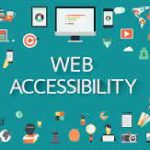The legal landscape of digital accessibility in K-12 education is quickly changing as schools recognize the importance of inclusion in the classroom. Technology and online resources are now essential in education, especially in K-12 schools. However, ensuring equal opportunities for all students, including those with disabilities, is a fundamental aspect of providing quality education. This brings us to the crucial topic of digital accessibility in K-12 education and the legal landscape surrounding it.
Digital accessibility refers to the practice of designing and developing digital content and technologies for individuals with disabilities. It aims to eliminate barriers that prevent students with disabilities from fully engaging in educational opportunities provided through digital platforms. Understanding the legal obligations of ensuring digital accessibility is crucial as schools and districts adopt technology in the classroom.
This article delves into the legal landscape of digital accessibility in K-12 education. By shedding light on the obligations that schools and districts have in this domain. We will explore key laws and regulations that outline the responsibilities of educational institutions in ensuring digital accessibility.
Legal Landscape of Digital Accessibility in K-12 Education: Key Laws and Regulations
Recent laws and regulations promote inclusive education and protect the rights of students with disabilities. These legal frameworks address the obligations of educational institutions, including schools and districts, in providing accessible digital content and technologies. Compliance with legal requirements ensures equal educational opportunities for all students in schools and districts.
Key regulations guide schools and districts to meet the digital accessibility needs of students with disabilities in K-12 education. Understanding these laws is crucial for educational institutions to ensure compliance and provide equal educational opportunities for all students. Let’s explore some of the primary laws and regulations that govern digital accessibility in K-12 education.
Individuals with Disabilities Education Act (IDEA)
The IDEA Act is a federal law that ensures students with disabilities receive a free appropriate public education (FAPE). Under IDEA, students with disabilities are entitled to special education services and accommodations that meet their individual needs. While IDEA does not explicitly address digital accessibility, it serves as a foundation for other laws that do.
Section 504 of the Rehabilitation Act
Section 504 of the Rehabilitation Act prohibits discrimination against individuals with disabilities in programs receiving federal funding, including K-12 schools. This law requires schools to provide equal access to educational programs and activities for students with disabilities. Section 504 applies to both physical and digital environments. This means that schools must ensure that their digital content and technologies are accessible to students with disabilities.
The Americans with Disabilities Act (ADA)
The Americans with Disabilities Act is a comprehensive civil rights law that prohibits discrimination based on disability. Title II of the ADA applies to public entities, including public schools and districts. It requires them to provide equal access to their services, programs, and activities. Courts have interpreted the ADA to include digital accessibility. Schools and districts are required to ensure accessibility of websites, online platforms, and other digital resources for individuals with disabilities.
Section 508 of the Rehabilitation Act
Section 508 of the Rehabilitation Act specifically addresses the accessibility of electronic and information technology (EIT) used by federal agencies. Although it primarily applies to federal entities, it has implications for schools and districts that receive federal funding. Section 508 sets forth standards for the accessibility of EIT, including websites, software, and digital content. While not directly applicable to K-12 schools, compliance with Section 508 can provide guidance for meeting accessibility standards.
Web Content Accessibility Guidelines (WCAG)
The Web Content Accessibility Guidelines (WCAG) are widely recognized as a set of international standards for digital accessibility. The WCAG provides specific guidelines and success criteria for creating accessible websites, online documents, and multimedia content. Many courts and regulatory agencies reference the WCAG when evaluating compliance with digital accessibility requirements.
Schools and districts must understand digital accessibility obligations in K-12 education by familiarizing themselves with laws and regulations. Compliance is crucial for promoting inclusive education and facilitating full student participation in digital learning environments.
Practical implications of these legal obligations on schools and districts
The legal obligations surrounding digital accessibility in K-12 education have practical implications for schools and districts. By understanding and fulfilling these obligations, educational institutions can create an inclusive learning environment that benefits all students. Here are some practical implications of these legal obligations.
Designing Accessible Websites and Platforms
Schools and districts must ensure that their websites, learning management systems, and digital platforms are accessible to individuals with disabilities. This involves implementing features such as alternative text for images, keyboard navigation, and captions for videos. Designing accessible websites and platforms allows students with disabilities to access information. And allows them to engage in online discussions, and participate in digital coursework effectively.
Providing Accessible Instructional Materials
Educational materials, including textbooks, documents, and multimedia content, should be made accessible to students with disabilities. This may involve providing materials in alternative formats, such as Braille, large print, or accessible digital formats. Accurate captions and audio descriptions in instructional videos enable full comprehension for students with hearing or visual impairments.
Utilizing Assistive Technologies
Schools and districts should consider the use of assistive technologies that enable students with disabilities to access educational resources. These technologies can include screen readers, speech recognition software, magnification tools, and alternative input devices. Providing access to assistive technologies helps students with disabilities navigate digital content and actively participate in classroom activities.
Training and Professional Development
Investing in educator and staff training is necessary for schools and districts to meet their legal obligations regarding digital accessibility. This ensures that they have the necessary knowledge and skills to create and deliver accessible digital content. Training programs can cover topics such as designing accessible documents, using assistive technologies, and understanding the principles of inclusive design.
Procurement and Vendor Contracts
When procuring digital products and services from vendors, schools and districts should consider accessibility requirements. Including accessibility criteria in vendor contracts can help ensure that the products and services purchased meet the necessary accessibility standards. This proactive approach contributes to the overall accessibility of the digital tools and resources used in K-12 education.
Schools and districts can foster an inclusive learning environment by addressing the practical implications of legal obligations. These steps are crucial toward promoting digital accessibility in K-12 education and enabling all students to fully participate and thrive.
Strategies that schools and districts can employ to meet the standards of digital accessibility
Schools and districts can implement strategies to ensure equal access to educational resources for all students and meet digital accessibility standards. Here are some effective strategies that educational institutions can employ.
Develop a Digital Accessibility Policy
Schools and districts should establish a clear policy that outlines their commitment to digital accessibility. This policy should define the standards, guidelines, and procedures for creating and maintaining accessible digital content. By having a policy in place, educational institutions can ensure a consistent and systematic approach to digital accessibility.
Raise Awareness and Provide Training
Educating staff, teachers, and administrators about the importance of digital accessibility is crucial. Schools and districts can organize training sessions and workshops to raise awareness and provide guidance on creating accessible content. Training programs should cover topics such as creating accessible documents, designing accessible websites, and utilizing assistive technologies. By equipping staff with the necessary knowledge and skills, schools can foster a culture of accessibility.
Collaborate with Accessibility Experts
Schools and districts can seek guidance from accessibility experts or consultants who specialize in digital accessibility. These experts can provide valuable insights and recommendations tailored to the specific needs of the educational institution. Collaborating with experts can help schools navigate complex accessibility challenges, implement best practices, and ensure compliance with legal requirements.
Implement Accessibility Standards
Schools and districts should adhere to recognized accessibility standards, such as the Web Content Accessibility Guidelines (WCAG). The WCAG provides guidelines and success criteria for creating accessible digital content. Schools can ensure that their websites, documents, multimedia content, and online platforms are accessible to individuals with disabilities.
Conduct Regular Audits and Assessments
Schools and districts should regularly assess their digital resources for accessibility compliance. Conducting audits and assessments helps identify barriers and areas that require improvement. Accessibility evaluations can include reviewing websites, learning management systems, online documents, and multimedia content to ensure they meet the standards.
Involve Students and Parents
Inclusive practices can be further enhanced by involving students and parents in the accessibility process. Schools can gather feedback from students with disabilities and their parents to understand their specific accessibility needs and preferences. This input can inform decisions about digital tools, platforms, and instructional materials, ensuring that they cater to diverse needs.
Engage with Vendors and Suppliers
When procuring digital products and services, schools and districts should consider accessibility requirements. Engaging with accessible-focused vendors and suppliers enhances the overall digital ecosystem accessibility of educational institutions. Including accessibility criteria in contracts can help ensure that products and services meet the necessary standards.
By employing these strategies, schools and districts can take proactive steps towards meeting the standards of digital accessibility.
Conclusion
Understanding and adhering to the legal landscape of digital accessibility in K-12 education is crucial for schools and districts. Inclusion for all students is crucial in the educational setting, given the growing reliance on digital tools and platforms.
Familiarizing with legal requirements helps schools and districts understand their obligations for accessible digital content and technologies. This includes considering web accessibility, document accessibility, assistive technology, and usability for students with diverse needs.
Failure to meet these obligations may result in legal challenges impacts the reputation and resources of schools and districts. Thus, proactive measures can help ensure compliance and create an inclusive digital learning environment.








